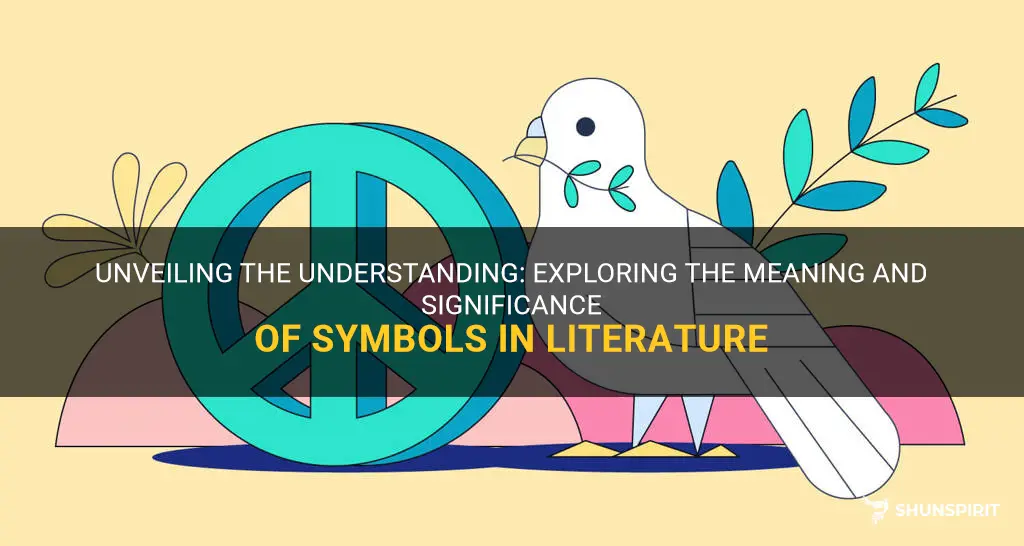
Symbolism is a powerful literary device that allows authors to convey deep meaning and provoke thought through the use of symbols. In literature, a symbol is an object, character, or event that represents a hidden meaning or concept. These symbols can range from simple everyday objects to more abstract ideas, allowing readers to engage in a deeper level of analysis and interpretation. By using symbols in their writing, authors can add layers of meaning and create a rich and meaningful reading experience. From a single object that signifies a whole, to a repeated motif that carries a specific theme, symbols in literature have the ability to transcend words and communicate profound emotions and ideas.
What You'll Learn
- How does the use of symbolism enhance the meaning and depth of a literary work?
- Can a symbol have different meanings for different readers, or does it have a fixed meaning assigned by the author?
- How do authors choose symbols for their works, and what factors influence their decision?
- Can symbols be universally understood and interpreted in the same way across different cultures and time periods?
- Are there any examples of symbols that have become iconic and widely recognized in literature?

How does the use of symbolism enhance the meaning and depth of a literary work?
Symbolism is a powerful tool used by authors to enhance the meaning and depth of their literary works. By using symbols, authors are able to convey complex ideas and emotions in a way that is accessible and relatable to the reader. Symbolism adds depth to a literary work, allowing the reader to delve into the deeper layers of meaning and interpretation.
One way in which symbolism enhances the meaning of a literary work is by adding another level of interpretation. Symbols can represent abstract ideas or concepts that are difficult to grasp or express directly. Through the use of symbols, authors can bring these ideas to life and make them tangible for the reader. For example, a red rose may symbolize love or passion, while a black crow may symbolize death or evil. By using these symbols, authors are able to convey complex emotions and concepts in a way that is easily understood and relatable to the reader.
Symbols also add depth to a literary work by creating a sense of universality. Symbols have the power to transcend cultural and language barriers, making them accessible to a wide range of readers. They tap into our collective unconscious, evoking emotions and ideas that are universally understood. For example, the image of a rising sun can symbolize hope and new beginnings, regardless of the reader's background or beliefs. By using symbols that are universally recognized, authors can create a sense of connection and resonance with their readers.
In addition, symbols can enhance the meaning of a literary work by adding layers of complexity and ambiguity. Symbols often have multiple meanings and interpretations, allowing readers to engage with the text on a deeper level. This ambiguity invites readers to actively participate in the interpretation of the work, making it a more interactive and thought-provoking experience. For example, the symbol of a locked door may represent both an obstacle to be overcome and a sense of mystery and intrigue. The multiple meanings of the symbol invite readers to explore different facets of the narrative and reach their own conclusions.
Furthermore, symbols can bring a sense of cohesion and unity to a literary work. By using recurring symbols throughout the narrative, authors can create a sense of continuity and thematic richness. Symbols can serve as motifs, echoing key ideas and themes throughout the work. This repetition of symbols helps to reinforce the central message or idea of the work, allowing readers to make connections and discover deeper layers of meaning.
In conclusion, the use of symbolism enhances the meaning and depth of a literary work by adding another layer of interpretation, creating a sense of universality, adding complexity and ambiguity, and bringing cohesion and unity to the narrative. By using symbols, authors are able to convey complex ideas and emotions in a way that is accessible and relatable to the reader. Symbols invite readers to engage with the text on a deeper level, making the reading experience more meaningful and thought-provoking.
Understanding the Symbol for Factorial Function: What Does It Mean?
You may want to see also

Can a symbol have different meanings for different readers, or does it have a fixed meaning assigned by the author?
Symbols can be powerful tools used by authors to convey deeper meaning and evoke specific emotions in their readers. However, the interpretation of symbols can vary among different readers, raising the question of whether a symbol can have different meanings or if it has a fixed meaning assigned by the author.
Symbolism is a literary device that involves using an object, person, or situation to represent an abstract idea or concept. It allows the author to add layers of meaning to their work, making it more profound and thought-provoking. When an author introduces a symbol into their writing, they often do so with a specific intention in mind. They choose symbols that align with the themes and ideas they want to explore in their work.
At first glance, one might assume that the meaning of a symbol is fixed, dictated by the author's intention. However, it is essential to consider that readers bring their own experiences, beliefs, and cultural backgrounds to their interpretation of a text. These factors can significantly influence how they perceive and understand symbols within a literary work.
One example of a symbol that can have varying interpretations is the color red. In Western culture, red is often associated with passion, love, and danger. However, in different cultures, red may symbolize luck, celebration, or mourning. This difference in interpretation stems from the diverse cultural contexts and personal experiences of readers.
Additionally, symbols can have individual significance for readers. A symbol may resonate with a reader based on their personal history or circumstances. For example, a broken mirror might symbolize bad luck or shattered self-image for someone who has experienced trauma, yet it might represent a fresh start or self-reflection for another reader who has overcome personal challenges.
Moreover, symbols can also evolve and change over time. As society grows and changes, so too can the interpretations of symbols within literature. For instance, the yellow wallpaper in Charlotte Perkins Gilman's short story "The Yellow Wallpaper" initially represented the narrator's descent into madness. However, in contemporary readings, it has come to symbolize the patriarchal oppression and the limitations placed on women during that time period.
While authors may have specific intentions when using symbols, it is impossible for them to predict how every reader will interpret their work. As readers, we bring our unique perspectives and experiences, which inevitably shape our understanding of symbols within a text. This subjectivity is what makes literature a dynamic and engaging art form.
In conclusion, symbols in literature can have different meanings for different readers. While authors may have specific intentions when using symbols, readers interpret these symbols through their own personal lenses, cultural backgrounds, and experiences. This subjectivity allows for a rich and diverse exploration of meanings, making literature a truly multi-layered and thought-provoking form of art.
Decoding the Hidden Meaning of the Starbucks Symbol
You may want to see also

How do authors choose symbols for their works, and what factors influence their decision?
Symbols play a significant role in literature, allowing authors to convey deeper meanings and themes through imagery. However, the process of choosing symbols for their works is not arbitrary; authors carefully select these symbols, taking various factors into consideration.
First and foremost, authors consider the overall theme and message of their work. Symbols are chosen to reinforce or enhance these themes. For example, in William Golding's novel "Lord of the Flies," the conch shell represents civilization and order. Through its symbolism, Golding emphasizes the importance of order in society and how it deteriorates when civilization is abandoned.
Authors also draw inspiration from their own experiences and cultural background. The symbols they choose may reflect personal beliefs, values, or experiences. This personal connection adds depth and authenticity to their work. For instance, J.K. Rowling's use of the phoenix in the Harry Potter series draws from various mythologies and the folklore of rebirth and resurrection. Rowling's fascination with mythological creatures and her background in classics influenced her choice to incorporate the phoenix as a symbol of hope and renewal in her novels.
Furthermore, authors consider their intended audience when selecting symbols. Different symbols carry different connotations and meanings for different cultures and societies. Therefore, authors must choose symbols that their readers can easily interpret and understand. For instance, in George Orwell's "Animal Farm," the farm animals represent different groups within society. The pig, Napoleon, symbolizes the manipulative and power-hungry leaders in politics, a symbol that resonates with readers familiar with political corruption.
The historical and social context of the work also influences the choice of symbols. Authors often draw from historical events, cultural movements, or social issues to create symbols that resonate with their readers. For example, in Harper Lee's "To Kill a Mockingbird," the mockingbird represents innocence and the oppression of marginalized communities. The symbol of the mockingbird reflects the racial tensions and social injustice prevalent during the time of the novel's setting.
Lastly, authors may intentionally choose symbols that are ambiguous or open to multiple interpretations. This allows readers to engage with the text on a deeper level, fostering discussions and exploration of different meanings. The intentional ambiguity of symbols also makes the work more versatile and relevant across different time periods and cultures.
In conclusion, authors choose symbols for their works based on various factors. These include the theme and message of the work, personal experiences and cultural background, the intended audience, the historical and social context, and the desire for ambiguity or multiple interpretations. Selecting symbols that resonate with readers adds richness and depth to the literary work, allowing authors to effectively convey their intended meanings and themes.
The Meaning Behind the Amazon Symbol: A Closer Look
You may want to see also

Can symbols be universally understood and interpreted in the same way across different cultures and time periods?
Symbols play a significant role in human communication and have been used for thousands of years across various cultures and time periods. They can represent ideas, concepts, emotions, and objects, allowing people to convey and interpret meaning without relying solely on verbal or written language. However, the interpretation and understanding of symbols may vary across different cultures and time periods.
Cultural differences are one of the primary factors that influence the interpretation of symbols. Each culture has its own set of symbols with specific meanings and associations. For example, in Western cultures, the color white typically represents purity or innocence, while in some Eastern cultures, it symbolizes mourning or death. Similarly, the thumbs-up gesture is widely recognized as a positive sign in many Western countries, but in parts of the Middle East, it is considered an offensive gesture. These examples highlight the variations in symbol interpretation based on cultural context.
Furthermore, symbols can evolve and change their meanings over time. The meanings associated with symbols may shift due to societal, political, or technological advancements. For instance, the swastika, originally a symbol of good fortune in Hinduism and Buddhism, is now predominantly associated with the Nazi regime and represents hate and discrimination. Similarly, the peace sign, which originated as a symbol for the Campaign for Nuclear Disarmament in the 1950s, has become a widely recognized symbol for peace and social justice. These changes in symbol interpretation demonstrate the impact of historical and contextual factors.
However, certain symbols have managed to maintain relatively consistent meanings across cultures and time periods. Basic symbols such as numbers, mathematical symbols, and common shapes like circles and triangles tend to retain their universal meanings. The number one, for example, represents singularity or unity across cultures. Similarly, the circle symbolizes completeness and infinity in various societies. These symbols have a strong foundation in human cognition and can be easily grasped and understood by people regardless of their cultural background.
In addition to cultural and temporal factors, individual experiences and personal associations also play a role in symbol interpretation. People may interpret symbols differently based on their personal background, education, and exposure. For instance, an artist may interpret a specific color differently from a scientist or a religious leader, as their perspectives and knowledge greatly influence their understanding of symbolism.
While symbols may not always be universally understood and interpreted in the same way across all cultures and time periods, they continue to hold immense importance in human communication. Symbols serve as a powerful tool to convey complex ideas in a concise and visual manner. Despite the variations in interpretation, symbols have the potential to bridge cultural gaps and facilitate cross-cultural understanding when used correctly and in the appropriate context.
What Does the & Symbol Mean and How Is It Used?
You may want to see also

Are there any examples of symbols that have become iconic and widely recognized in literature?
Symbols have long served as powerful tools in literature, allowing authors to convey deeper meanings and evoke emotional responses from readers. Certain symbols have become iconic and widely recognized, transcending their original context to become universal symbols of human experiences. Here are a few examples of such symbols:
- The Red Rose: The red rose has long been associated with love and passion. This symbol is deeply rooted in literature, dating back to ancient Greek and Roman poetry. In William Shakespeare's play "Romeo and Juliet," the red rose symbolizes the intense love between the two young protagonists. The image of the red rose has since become a universal symbol for love and romance.
- The White Whale: In Herman Melville's novel "Moby-Dick," the white whale symbolizes various themes, such as the force of nature, the relentless pursuit of a goal, and the ambiguity of evil. The image of the white whale has become a symbol of obsession and the destructive nature of unchecked ambition.
- The Green Light: In F. Scott Fitzgerald's novel "The Great Gatsby," the green light at the end of Daisy Buchanan's dock symbolizes Gatsby's dreams and aspirations. It represents the pursuit of the American Dream and the hope for a better future. The image of the green light has since become synonymous with unattainable dreams and the fleeting nature of happiness.
- The Mockingjay: In Suzanne Collins' "The Hunger Games" trilogy, the mockingjay bird symbolizes rebellion and defiance. It serves as a symbol of hope and resistance against the oppressive government of Panem. The image of the mockingjay has become a widely recognized symbol of rebellion and social justice.
- The Ring: In J.R.R. Tolkien's "The Lord of the Rings," the One Ring symbolizes power and corruption. It represents the temptations of absolute power and the dangers of succumbing to its allure. The image of the ring has since become a symbol for the corrupting influence of power in various contexts.
These examples illustrate how symbols can transcend their original literary contexts and become iconic symbols that resonate with readers across different cultures and time periods. Symbols like the red rose, white whale, green light, mockingjay, and the ring have become widely recognized and imbued with universal meanings, enriching the reading experience and inviting deeper interpretations of literary works.
Unveiling the Hidden Meanings Behind Roman Symbols and Their Significance
You may want to see also
Frequently asked questions
In literature, a symbol is a literary device that represents an idea, concept, or object by using something else. It can be a word, phrase, object, or event that stands for a deeper meaning or theme in the story. Symbols can be used to enhance the overall meaning of a piece of literature and add depth and richness to the text.
Symbols are used in literature to convey complex ideas and emotions in a more abstract and indirect way. They can help create a deeper understanding and interpretation of the text, as readers must decipher the symbol's meaning and connect it to the larger themes and messages of the story. By using symbols, authors can add layers of meaning to their work and engage readers on a deeper level.
Authors use symbols in literature for a variety of reasons. One reason is to add depth and complexity to their work, as symbols can evoke emotions and ideas that go beyond what can be expressed through direct language. Symbols also help to create a sense of universality and allow readers to connect with the text on a more personal level. Additionally, symbols can be used to convey themes and ideas that are difficult to express in concrete terms.
Interpreting symbols in literature is a subjective process that can vary from reader to reader. Readers must analyze the context in which the symbol is used, consider the author's intentions, and draw on their own personal experiences and knowledge to make sense of the symbol's meaning. It is important to remember that not all symbols have a fixed or definitive meaning, and different readers may interpret symbols in different ways.
There are many common symbols used in literature that have universal meanings. Examples include the color red, which often symbolizes love or passion, or a rose, which can represent beauty or romance. Other common symbols include the sun, which can symbolize life or enlightenment, or a snake, which may represent temptation or evil. However, it is important to note that the meaning of symbols can vary depending on the specific context in which they are used.







